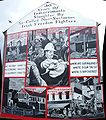- Murals in Northern Ireland
-
Murals in Northern Ireland have become symbols of Northern Ireland, depicting the region's past and present political and religious divisions.
Northern Ireland contains arguably the most famous political murals. Almost 2,000 murals have been documented in Northern Ireland since the 1970s. The murals tend to represent one side's political point of view, or commemorate an event or person(s) involved in the history of Northern Ireland, particularly during the Troubles.
Contents
History
Almost all Northern Ireland murals promote either republican or loyalist political beliefs, often glorifying paramilitary groups such as the Provisional Irish Republican Army, Ulster Freedom Fighters, and the Ulster Volunteer Force, while others commemorate people who have lost their lives in paramilitary or military attacks.
The most famous of the murals in Northern Ireland may well be Free Derry Corner, where the slogan "You Are Now Entering Free Derry" was painted in 1969, shortly after the Battle of the Bogside. However, some do not consider Free Derry Corner to be a true mural, as it consists only of words and not images. Free Derry Corner has been used as a model for other murals in Northern Ireland, including the "You Are Now Entering Loyalist Sandy Row" mural in Belfast, which was a response to the republican message of Free Derry Corner, and the "You Are Now Entering Derry Journal Country" mural, which is an advertisement for a Derry publication.
Not all murals in Northern Ireland are directly political or sectarian in nature, with some commemorating events such as the Great Irish Famine (1845–1849), and other moments in Irish history. Many portray events from Irish mythology, though images from Irish myths are often incorporated into political murals. A few murals avoid the subject of Ireland altogether, instead focusing on such neutral subjects as litter prevention and the C. S. Lewis novel The Lion, the Witch and the Wardrobe. Murals representing peace and tolerance are becoming increasingly popular with school groups who have children either design or actually paint murals in areas around their schools. Additionally, with many paramilitaries now involved in community work there has been a move to decommission many of the hard-edged murals across Northern Ireland.[1] This change was further highlighted in 2007, when the Bogside Artists artists were invited to Washington, D.C. for the Smithsonian Folk Life Festival. The three artists were invited to recreate murals in the Washington Mall.[2]
Examples
Nationalist and republican
-
A mural in Belfast depicting the Easter Rising of 1916
-
A mural in Derry depicting the Battle of the Bogside
-
A mural in Derry depicting the Civil Rights movement
-
A mural in Derry depicting Bernadette Devlin McAliskey
-
A mural in Derry depicting Bloody Sunday (1972)
-
Free Derry mural.
-
A mural in Derry depicting Operation Motorman
-
A Famine mural in Belfast
-
A mural in Belfast depicting the 1981 republican hunger strike
-
A mural dedicated to republican hunger striker Bobby Sands
-
A mural in Derry dedicated to republican hunger striker Patsy O'Hara
-
A mural in Belfast dedicated to Cumann na mBan
-
A mural in Belfast dedicated to the IRA volunteers killed in Operation Flavius
-
A mural in Belfast depicting the Manchester Martyrs
Unionist and loyalist
-
An Ulster Volunteers/UVF mural in Bangor
-
A Red Hand Commandos mural in Bangor
-
A mural in Belfast depicting William III of England
-
A mural in Belfast showing solidarity with the Portadown Orangemen
-
A mural in Newtownards depicting the Ulster Special Constabulary and Ulster Defence Regiment
-
Mural dedicated to James Joseph Magennis in east Belfast.
-
A Loyalist mural in Rowland Street, Sandy Row, south Belfast, 1981.
-
A mural in Belfast depicting Oliver Cromwell
Other
-
A mural in a loyalist area dedicated to George Best.
-
A mural dedicated to the sinking of RMS Titanic.
-
A Mural in the village marking Linfield's contribution to the Northern Ireland team
See also
References
- ^ "Old masters change murals". BBC News. 2005-05-31. http://news.bbc.co.uk/2/hi/uk_news/northern_ireland/4562793.stm. Retrieved 28 November 2008.
- ^ Taggart, Maggie (2007-06-22). "Painting a New Image of NI". BBC News. http://news.bbc.co.uk/2/hi/uk_news/northern_ireland/6231216.stm. Retrieved 28 November 2008.
External links
- Up to date map of Belfast murals
- Photographs of murals from Belfast and Londonderry
- Photographs of Belfast murals
- Political wall murals in Northern Ireland
- A collection of loyalist murals in Northern Ireland
- A collection of republican murals in Northern Ireland
- Collection of Republican murals and monuments
- Collection of Loyalist murals
- Flickr group: Northern Ireland political murals
- Routes of Reconciliation: Visiting Sites of Cultural Trauma in the U.S. South, Northern Ireland, and South Africa by Charles Regan Wilson, Southern Spaces, March 26, 2009
- Take an online tour of the murals in Belfast, Northern Ireland
Further reading
- B. Rolston (1992). Drawing Support: Murals in the North of Ireland. Belfast.
- Oona Woods (1995). Seeing is Believing? Murals in Derry. Guildhall: Printing Press. ISBN 0-946451-31-1.
- B. Rolston (1995). Drawing Support 2: Murals of War and Peace. Belfast.
- B. Rolston (2003). Drawing Support 3: Murals and Transition in the North of Ireland. Belfast.
Categories:- Irish paintings
- Art in Northern Ireland
- Murals
- Politics of Northern Ireland
- Works about The Troubles (Northern Ireland)
- Political art
Wikimedia Foundation. 2010.





























































